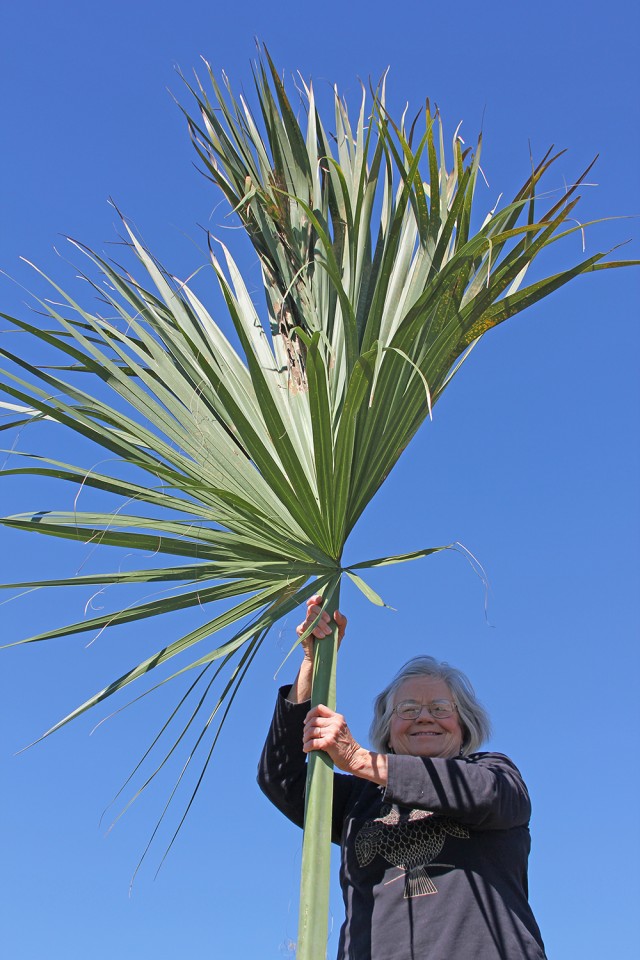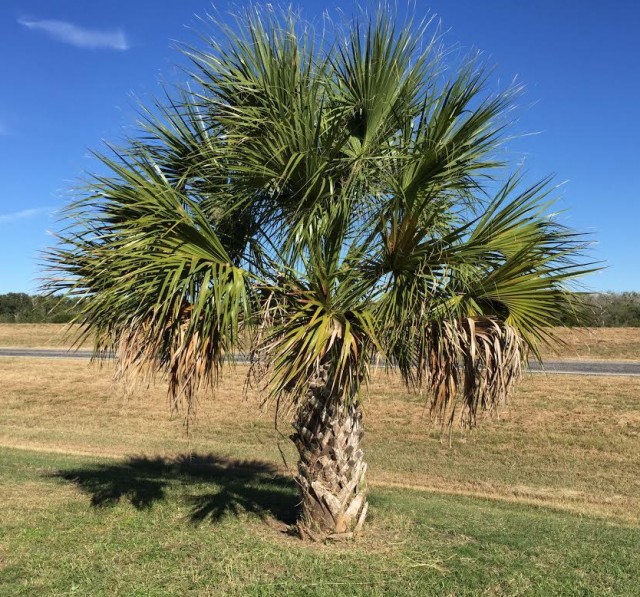
Palm fronds are some of the biggest leaves in the world. This is a single leaf of a Mexican Sabal Palm. Notice that the leaf stalk, or petiole, has smooth edges (or I would not be holding it so tightly!.) Other species of palms are “armed” with sharp teeth along the petioles. Robert Benson photo.
“Lost” Palms Found On Medio Creek
For years I have known about the palm trees growing in the draw of Medio Creek in Bee County. I could see them: one on the east side of Highway 181 and one on the west side. They formed bright green beacons in the brushy vegetation of the creek bed. I knew the creek trickled through the draw almost 20 feet below the level of the 181 bridge.
These palms were growing in a wet area, so I decided that they were specimens of our native little palm, the Dwarf Palmetto. On about the 57th time I passed by these palms, I realized that they were exceptionally tall for palmettos. In fact, these palms were really BIG. Since they could be seen from the level of the roadway, they had to be over 30 feet tall!
Whoa! Wait a minute! I had to reconsider my casual drive-by identification. These palms had fan-shaped leaves, were growing in damp ground, and seemed to be wild. I looked up Texas palms and found only two species are native: the Dwarf Palmetto (Sabal minor) and the Mexican Sabal Palm (Sabal mexicana).
Although these two palms are in the same genus, Sabal, there are some distinct differences. The palmetto almost never grows taller than 8 feet and has no trunk. It looks like the leaves just sprout out of the ground. The Mexican Sabal Palm has a rather massive trunk, and easily grows to 30 feet high or more.
But when I checked the ranges of these two species I was surprised to find that the Mexican Sabal is restricted to the lower Rio Grande Valley. A sanctuary has been established near Brownsville for what is believed to be the last remaining stand of old-growth Sabal mexicana in Texas. The 527- acre refuge is maintained by the Audubon Society and the Gorgas Science Foundation and is known as the Sabal Palm Sanctuary. This remnant of Sabal Palm forest is a prized bird-and-butterfly-watching location as well as the site of these magnificent palms.

This sabal palm is part of the landscaping group of palms growing in the entrance park along Highway 181 in Beeville. Notice the crosshatch pattern the old leaf bases make on the trunk. Mexican Sabal Palms have been planted all over South Texas. Original old growth stands of sabal palms have been identified in the Rio Grande Valley and as far north as Garcitas Creek in Victoria County. Robert Benson photo.
Mexican Sabal Palms are abundant in Mexico and they used to grow all along the lower Rio Grande River. Historical evidence exists that they also grew along many of the other rivers of the Texas Gulf Coast. But Sabal palms have two characteristics that contributed to their near extirpation. The terminal bud is a tender and delicious vegetable known as a palm heart. Many indigenous peoples used palm hearts as a welcome addition to their diet. Unfortunately, cutting out the “heart” kills the tree. Another characteristic of the palm is that the wood is impervious to shipworms and made excellent and long-lasting pilings for wharves. So whether they were cut down for their wood, or eaten as a delicacy, many of the S. mexicana palms disappeared from Texas.
However, one man did not believe that they were all gone. His name was Landon Lockett. A linguist by training, a lawyer by trade, but a naturalist by inclination, Dr. Lockett tirelessly searched for remaining pockets of sabal palms in Texas. He found a population along Garcitas Creek in Victoria County, just four miles upstream from Lavaca Bay. Many of these palms were 20 to 25 feet tall!
But one of his most exciting finds was a stand of palms in Brazoria County. Although many thought these palms were palmettos, Dr. Lockett persisted in his research to prove otherwise. Working with the chief palmologist from the Smithsonian, he eventually established that they were actually hybrids. But of which species? They “may be hybrids between sabal palm and dwarf palmetto, or possibly between the sabal and an as-yet-unidentified palm,” wrote Lockett in 1991. Or they may represent a new species of palm altogether!
Whether they are hybrids or a new species, these palms are a fascinating find for botanists. Ongoing DNA studies on these palms should eventually tell us more about them. Meanwhile, Landon Lockett sought and obtained funding for the protection of the Brazoria County palms. They are now protected within the boundaries of the San Bernard National Wildlife Refuge.
Could our Medio Creek palms be hybrids? I rather doubt it. Looking closely at the trunks and the fronds, I believe our palms are Sabal mexicana. Are they a remnant population that has always been growing along the creek? This would be very hard to prove given that sabal palms are widely used as landscaping palms. And in South Texas Sabal mexicana readily naturalizes (this might be expected of a species that previously grew here.)
Locally, we found several specimens of Mexican Sabal Palm planted in yards, cemeteries and parks. The most accessible palms can be found in the northern “entrance to Beeville park area” where Business 181 diverges from the Bypass. The palms in this park are of two kinds: Mexican Sabal Palms and another popular landscape palm, the Mexican Fan Palm (Washingtonia robusta.) You can easily distinguish between the two by looking at the petioles (leaf stems). Sabal palms have smooth, unarmed petioles while Washingtonia palms have orange, wicked, saw-like teeth on the edges of their petioles!
So the Medio Creek palms may just be naturalized specimens that came from planted trees. However, the palms in the creek bed appear to be bigger and older than any of the landscaped ones we found. Were they here all along? – Karen L. P. Benson
If you would like to offer comments, please click through to the discussion page
